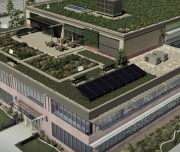System Impacts
Resources Impact
Planted roof systems have a significant impact on the building's overall energy and material consumption. Take into consideration these impacts when implementing a planted roof project in order to optimize building performance.
Energy
Materials
Best Practices and Strategies
| Consider coupling photovoltaics with a planted roof to optimize performance (see Solar/Photovoltaic). | Utilize an integrative team to determine the best strategies to optimize building performance. | Consider not only how the construction materials are managed but also how management of planted roof materials will continue in the future. |
| During construction, ensure there is adequate drainage to prevent erosion of the growing media from stormwater. | Determine which planted roof type is appropriate for your building project goals. | Educate the local community about food production and seasonal variety. |
| Consider local zoning regulations and policies when installing rooftop gardens for food production. |

